Tis the season to really get serious about what sunscreen you are going to want to have on hand so you are prepared for a day spent in the sun. Of course, we all want only the best sunscreen products with natural ingredients. So, I thought what better time to share about natural sunscreens than at the start of the spring and summer season.
In the past I have used the Environmental Working Group (EWG) to do just that. However I will be branching out and sharing some sunscreens that aren’t rated by the EWG, but I have vetted myself:)
I’ll be honest, there is a lot to weed through when it comes to sun care products. But the good news is that I am going to help you do that. I have been testing out various sunscreens for years and I am bringing you only the best of the best and taking out all of the guesswork. Also, in case you are wondering, the sun care market isn’t going anywhere!
The U.S. sun care market size was estimated at USD 1.95 billion in 2016 (1).
Suzi(Gurl Gone Green) is a participant in the Amazon Services LLC Associates Program, an affiliate advertising program designed to provide a means for sites to earn advertising fees by advertising and linking to amazon.com.
*Affiliate Disclosure: I do have affiliate links in this blog post. If you purchase something from my link, I will receive a small commission from the sale. This comes at no cost to you, but is paid by the company. I do not take becoming an affiliate with any company lightly. If I am, it’s because I believe in the company and their product.
What is the Environmental Working Group (EWG)?
The EWG is a nonprofit organization that was formed in 1993. They specialize in research, and advocacy when it comes to toxic chemicals, drinking water pollutants, corporate accountability, and agricultural subsidies.
It’s an organization that exists to help empower people with knowledge to make an informed decision when it comes to the food they’re consuming and the products they use in their homes and on themselves. I couldn’t love what they stand for anymore! They really are challenging the status quo and helping the consumer to think twice about conventional products and methods.
Every year the EWG sunscreen guide comes out where they vet and share safe sunscreen options. They list them in categories, ranging from beach and sport sunscreens, kid’s options, best-tinted moisturizers with SPF, and best lip balms with SPF. This is a great resource to help see what sunscreens are safe and which are not. The Sunscreen guide for this year has yet to be released.
After a 34-year process of reviewing sunscreen safety and efficacy, the Food and Drug Administration has not yet finalized rules on sunscreen ingredient safety and product effectiveness(2).
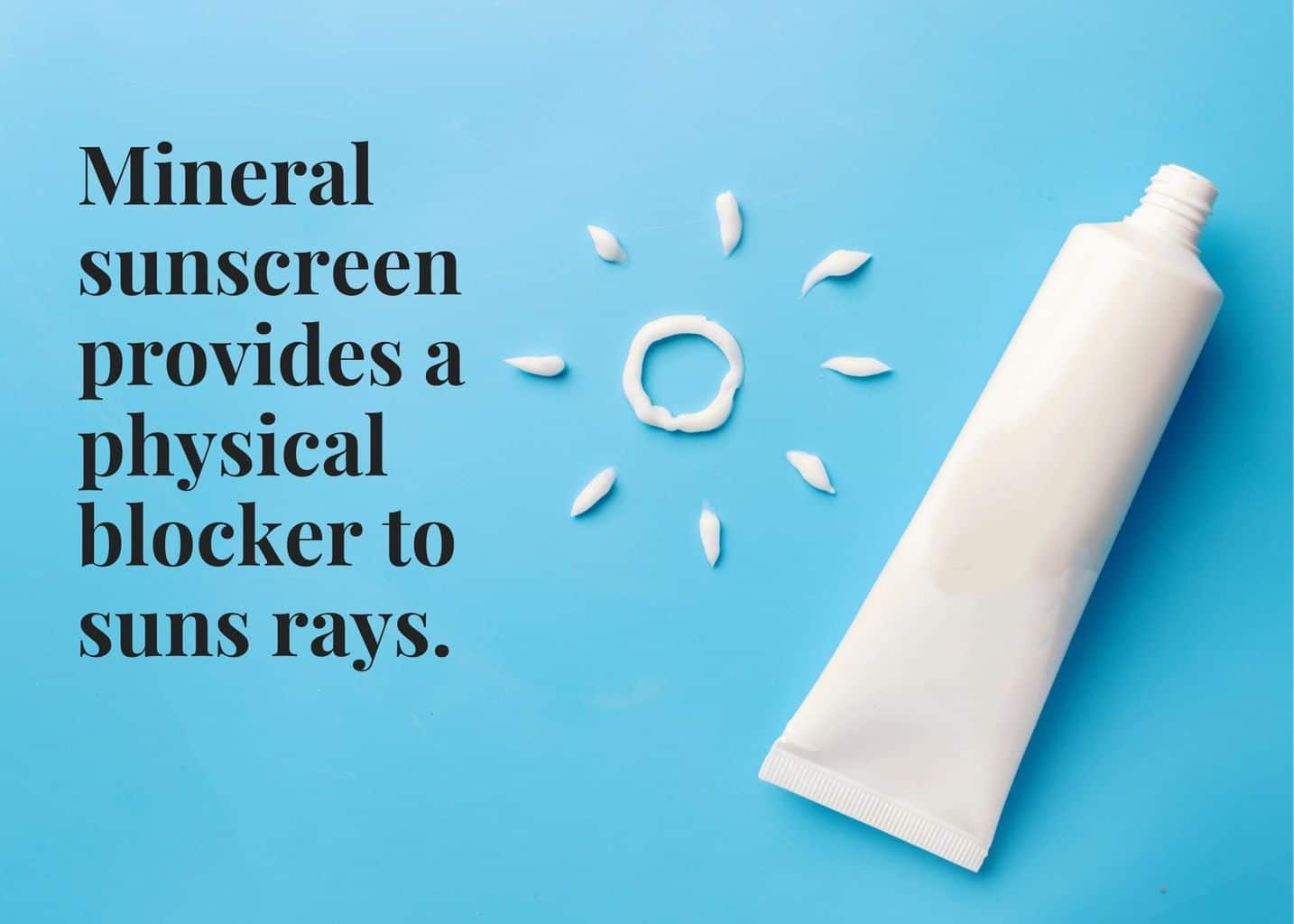
How does the EWG rate sunscreens?
If you’re not familiar with EWG, they have a category on their website called Skin Deep. It rates products on a scale of 1-10, 1 being the best and 10 being the worst.
You can enter in a product name and it will calculate if it’s safe or not based on certain criteria. They also list why it might get a higher score.
For example, you can type in a certain brand of sunscreen and get scoring on it, seeing why it might rank higher or lower depending upon ingredients. This is really helpful in learning more about which ingredients are harmful and which are safe.
I want to explain how the EWG rates its sunscreens and the criteria it goes off of. I get a lot of questions asking about their specific scoring, so I thought I would break it down for you. They first rate it on a scale of 1-10. Again, 1 being the best and 10 being the worst. It then rates each sunscreen based on 5 categories.
- Health Hazards
- UVB Protection
- UVA Protection
- The ratio of UVA absorbance to SPF
- How long lasting the sunscreen is
I applaud the EWG for all the work it’s done in creating a system of checks and balances that the consumer can use. I do think the EWG is a reliable source for vetting products. It helps to inform and educate consumers on what ingredients are and the common ones to avoid. It’s obviously not a fail-proof system, but overall I think it’s a great place to start when you are searching for the safety of a particular product.
Like I mentioned already, I’m going to share some EWG sunscreen picks that have been approved by them, including what they have been rated. However this year I am branching out and sharing some sunscreens that have clean ingredients that haven’t been rated yet by the EWG. I wanted my picks to be the best of the best and didn’t want to be limited if they hadn’t been rated yet.
Sunscreen Tip: Apply enough sunscreen to cover all skin that clothing will not cover. Most adults need about 1 ounce — or enough to fill a shot glass — to fully cover their body (3).
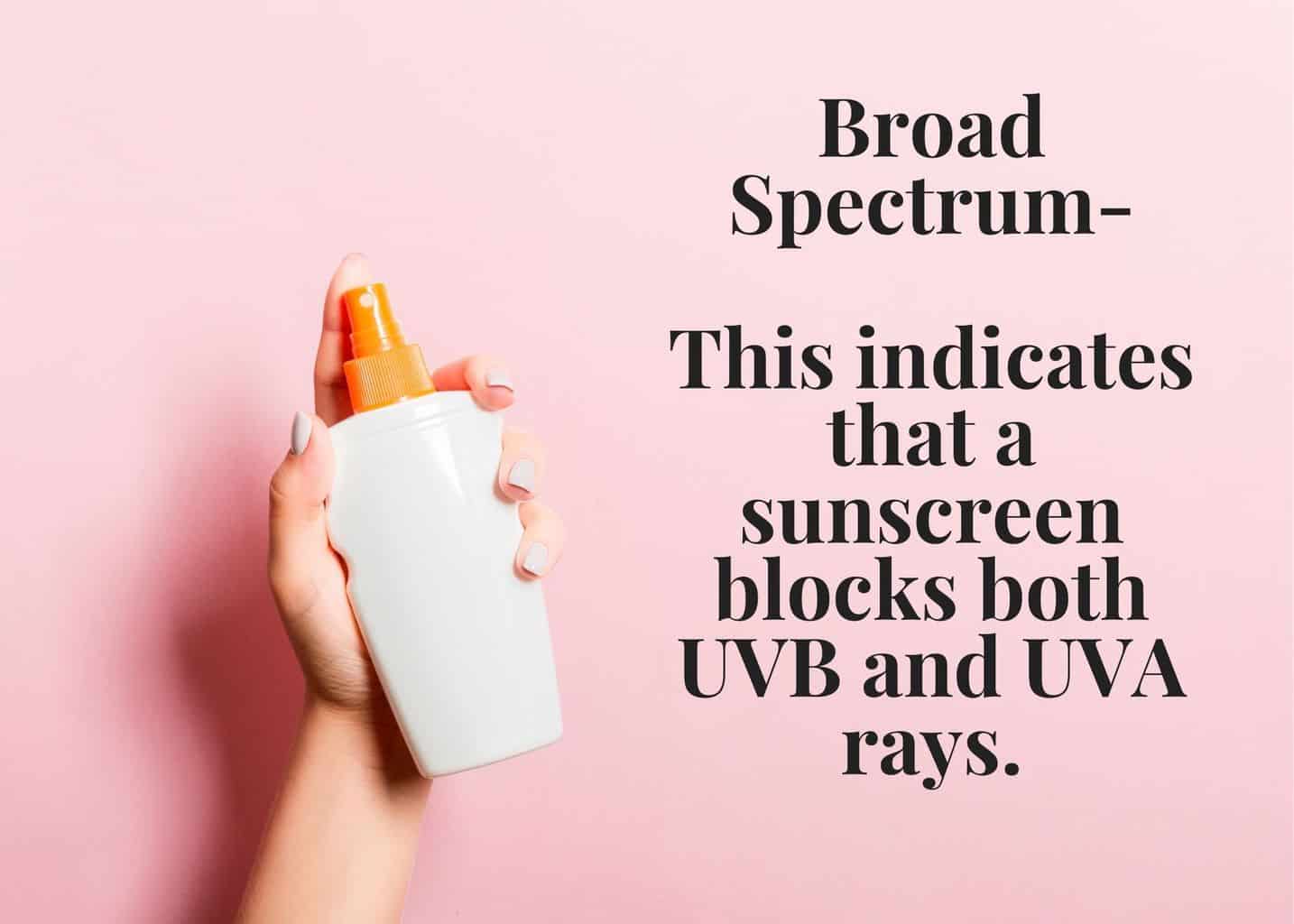
Chemical versus Mineral Sunscreens
In order to share the benefits of clean sunscreen, we first have to dive into the harmful effects of conventional sunscreens. These are known as chemical sunscreens contain these big long words. They can have one or a combination of these six ingredients: oxybenzone, avobenzone, octisalate, octocrylene, homosalate and octinoxate.
Instead of blocking the suns rays, like mineral sunscreens do, they absorb the rays, and turn them into heat, which are then transferred from skin to the air. These chemicals are known hormone disruptors (4). The scary fact about these chemicals is the high absorption rate, compared to other ingredients(5).
Hormone disruptors with high absorption rates is not something you want coupled together. Chemical sunscreens can also produce free radicals, which cause skin damage, skin irritation and aging. Can you say NO THANK YOU! Plus, they damage the sea and all its creatures and plants(6).
Coral bleaching (i.e., the release of coral symbiotic zooxanthellae) has negative impacts on biodiversity and functioning of reef ecosystems and their production of goods and services (8).
So what’s the alternative?? Clean sunscreens! These sunscreens are also known as mineral or physical sunscreens. These sunscreens either use titanium dioxide, zinc oxide or a combination of both. They are natural minerals that are ground up.
The main benefits of clean sunscreens are that the minerals reflect the sun’s rays instead of absorbing them, and they offer broad-spectrum protection. Not only that, but they start working the moment you apply them to your skin, unlike chemical sunscreens where you have to wait 20 minutes. Who wants to wait anyways?! Plus, these aren’t going to irritate your skin compared to chemical sunscreens and they won’t hurt the ocean and are reef-safe sunscreens – unlike the chemical sunscreens discussed above
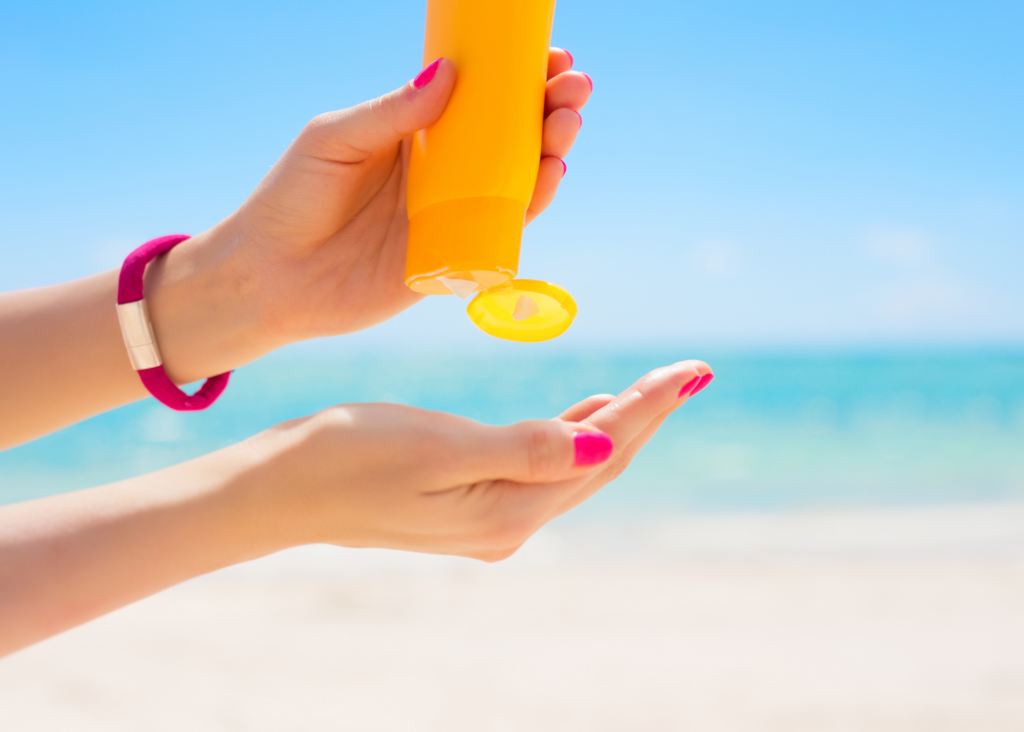
Here are a couple terms to look for when searching for natural mineral sunscreens and what they mean:
- UVB/UVA- There are many rays present in sunlight but the most harmful are UV rays- ultraviolet rays. The two rays that reach the earth’s surface are, UVB and UVA. UVB rays are the rays that cause sunburn and can cause skin cancer. UVA rays also can contribute to skin cancer and penetrate the skin even further causing skin aging. There are many more UVA rays in sunlight than UVB. It’s important to block both UVB and UVA rays. Chemical sunscreen typically only block UVB, while mineral sunscreen blocks UVB and UVA. When a sunscreen blocks both UVB and UVA it is called broad spectrum.
- Broad Spectrum- This indicates that a sunscreen blocks both UVB and UVA rays.
- Zinc Oxide, Titanium Dioxide- These are what you want to look for when searching for a natural mineral based sunscreen, versus a chemical sunscreen. These both are naturally occurring minerals. When they are used in sunscreen, they block the sun’s rays from being absorbed into your skin. The UV rays bounce off of your skin when you have either mineral applied.
- Water Resistant- When you see the words water resistant on a label it means that the sunscreen is effective for either 40 minutes or 80 minutes depending on what the label states. That means you will need to reapply the sunscreen after the 40 or 80 minutes to make sure it is still effective. Look for this label if you’re going to be in the water or excessively sweating(9).
- Sun Protection Factor (SPF)- It is recommended to use an SPF of 30 at minimum. SPF 15 blocks 93% of rays studies show, while SPF 30 blocks 97% of rays. You can go up in SPF after 30 however and reach the maximum benefit of sun blocking. Studies have shown the higher SPF you use the greater overall skin protection you will have (6).
- Rubs in Clear- If you don’t see “rubs in clear” on a label of mineral SPFs, be mindful that the product will be a white hue on your skin. However, if you do want it to rub in clear, make sure and get a sunscreen that says rubs in clear.
- Non-nano- This term has been popping up all over on sunscreen labels. When a product is nano-sized it means that they have formulated it so small that it can easily be rubbed into the skin and not be seen. Since the issue often with mineral sunscreens is the white hue it casts on the skin more companies have been creating nano-sized particles so it absorbs clear. Some concern has risen that nano-sized particles can seep past the skin and into the bloodstream. Although research has not confirmed it. The biggest concern is the harm they’re causing to marine life(10).

Tips to Protect Your Skin Beyond Sunscreen
Sunscreen should be the last line of defense to protect your skin from the sun. So, here are a few tips to minimize sun damage to your skin by too much sun exposure:
- Plan your outdoor time around the sun. The sun’s UV rays are strongest in the middle of the day – typically 10am to 4pm. So, it’s a good idea to spend more time outdoors in the early morning and evening hours. You can even play it safe by checking the UV index in your area.
- Cover up. This can include protective clothing like hats, shirts, shorts, pants, swim shirts, etc to provide UV protection.
- Utilize shade. Whether it be in the shade of a tree or creating your own shade with an umbrella this will protect your skin from the sun’s rays and keep you cooler.
- Wear sunglasses. This will protect your eyes from those same UV rays that can be so damaging.
Now that you know all the details on what makes clean sunscreen better when compared to conventional brands, plus how to protect your skin beyond sunscreen, let’s dive into my top picks for healthiest sunscreen options.
Best Natural Sunscreen Picks
I am sharing all my top picks for sunscreens. When I first came out with my sunscreen guide I only chose sunscreens that were rated by the EWG. I am changing it up this year as there are many great sunscreens out there that aren’t on the EWG. But I have vetted the sunscreen ingredients myself. You can feel confident in choosing any of these knowing they won’t have any harmful chemicals in them and they are all effective sunscreen products.
Best Natural Body Sunscreens
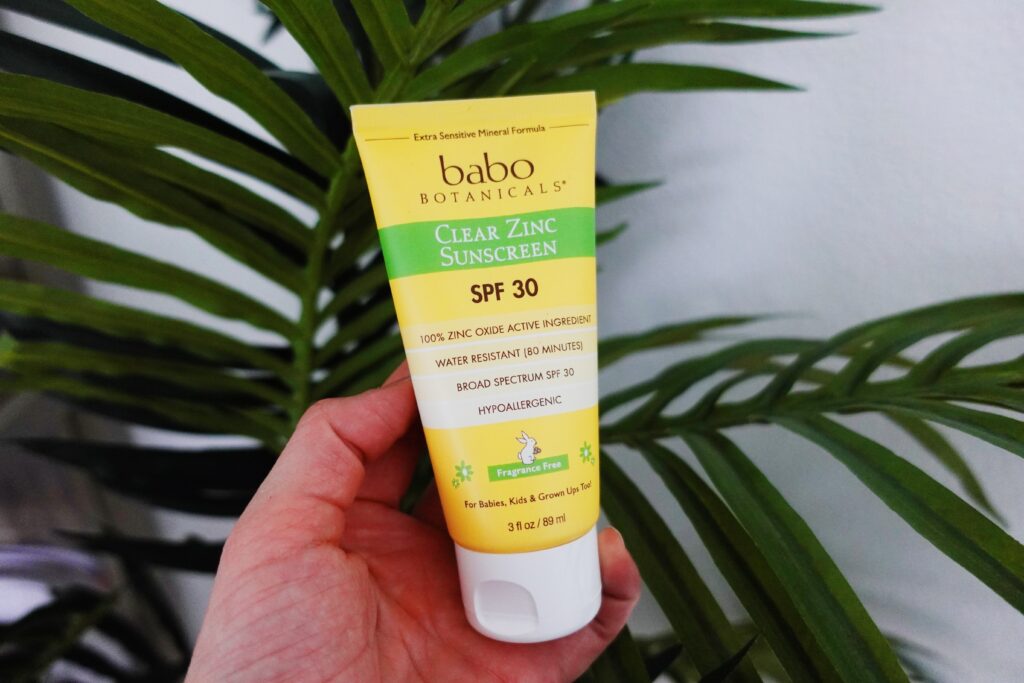
Babo Botanicals Clear Zinc Mineral Sunscreen
Formula: This is a great smooth formula, hydrating but doesn’t feel greasy. Comes in a tube.
SPF: 30
Active Ingredient(s): Zinc Oxide 16.0%
White Cast: None – rubs in clear!
Water Resistant: Up to 80 minutes
EWG Score: 2 – check it out here.
Price: $17.50
Review
I found this sunscreen before at Target (you can also get at Wal-mart)! I was so excited to find a budget friendly option when it came to mineral sunscreen that I didn’t have to order online. I love how it’s unscented too, making it great for delicate baby skin and even sensitive adult skin.
Related Content: Babo Botanicals Sunscreen Review
Juice Beauty Sport Sunscreen SPF 30
Formula: Comes in a tube. Definitely a heavier formulation than others. However, once you rub in it doesn’t feel heavy.
SPF: 30
Active Ingredient(s): 20% zinc oxide
White Cast: Initially you think it’s going to be white, but as you rub in it blends well and you can barely see a whitish hue.
Water Resistant: Up to 80 minutes
EWG Score: 2 – check it out here!
Price: $20
Review
After using this last summer my husband and I were both so impressed with it! It really delivered when it came to protection but also not feeling greasy. It really stayed on too even when we were in the water.
Indie Lee Mineral Sunscreen SPF 30
Formula: Comes in a tube. Is non-greasy yet moisturizing. This is a creamy texture and when you apply it feels like it might be greasy but then when it dries you feel like you have nothing on.
SPF: 30
Active Ingredient(s): 20% zinc oxide
White Cast: It doesn’t leave a white cast.
Water Resistant: Up to 40 minutes
EWG Score: No score available
Price: $42
Review
This sunscreen works great. It was another fave I found from last summer. It stays on well and was hydrating but not greasy feeling once rubbed in. It also didn’t leave my skin looking ghostly white which I love!
Best Natural Face Sunscreens

Blissoma Photonic Light Shifting Solution SPF25
***Also Best Natural Tinted Face Sunscreen***
Formula: It goes on smooth and is matte. Doesn’t feel heavy at all.
SPF: 25
Active Ingredient(s): 12.5% Micronized zinc oxide
White Cast: No white cast at all. It’s slightly tinted so blends in well to the skin.
Water Resistant: No
EWG Score: No score available
Price: $58
Review
This is such a great everyday moisturizer sunscreen for the skin. It protects but doesn’t leave it feeling greasy but matte. It’s acne friendly too. I love wearing this under makeup as well, doesn’t feel heavy.
Le Prunier Plumscreen
***Also Best Natural Sunscreen For Sensitive Skin***
Formula: Comes in a tube. A creamy lotion that feels more like a serum.
SPF: 31
Active Ingredient(s): 4.7% non-nano zinc oxide
White Cast: None
Water Resistant: No
EWG Score: No score available
Price: $78
Review
This sunscreen is really the best. It applies so smoothly, and doesn’t feel greasy or heavy at all. It really feels so good on the skin. Perfect before makeup. I love that it uses Plum to provide broad spectrum sun protection. It truly is so cool! Because of the plum oil they are able to limit the zinc oxide to 4.7%, which is much less than other mineral sunscreens. The scent is a very subtle version of the Le Prunier Plum Beauty Oil. I used this all last summer and was so impressed with how it protected my skin. I can’t recommend it enough!
Related Content: Le Prunier Review
Honua Malu Protecting Day Cream SPF 30
Formula: It feels like a light lotion. Not heavy at all, moisturizing.
SPF: 30
Active Ingredient(s): 12% zinc oxide
White Cast: No white cast.
Water Resistant: No
EWG Score: No score available
Price: $42
Review
This has been my go to for a facial sunscreen for years. They really nailed the formula so well. It feels hydrating, but not greasy at all. It acts like a primer before applying your makeup. I love how it feels just like an everyday moisturizer but with sunscreen added.
Best Natural Sunscreens for Babies & Children

Pipette SPF 50 Mineral Sunscreen
***Also Best Sunscreen For Sensitive Skin***
Formula: Lightweight lotion that comes in a tube – no greasy feeling
SPF: 50
Active Ingredient(s): 20% zinc oxide
White Cast: Subtle white cast once rubbed into the skin, but it’s very light.
Water Resistant: No
EWG Score: 3 – check it out here!
Price: $15
Review
I would recommend the Pipette Sunscreen to anyone! It really hits all the marks for a clean sunscreen that protects the skin and can be used for all ages. I love knowing I don’t have to pack a separate sunscreen for my kids but can all use one!
Related Content: Pipette Sunscreen Review
Babo Botanicals Baby Skin Mineral Sunscreen SPF 50
Formula: A lightweight lotion
SPF: 50
Active Ingredient(s): 20% zinc oxide
White Cast: I don’t think it leaves a white cast but I wouldn’t say it’s 100% sheer. I find that once I initially rub the lotion in you can see a subtle hue but then as it dries it’s almost undetectable.
Water Resistant: Up to 80 minutes
EWG Score: 3 – check it out here!
Price: $17.50
Review
This is my go to for a baby sunscreen and the one I’m constantly recommending when people ask me for a natural baby sunscreen option. It works so well and I love the higher SPF rating on it. It doesn’t feel greasy and does rub in mostly clear. I like how it’s fragrance free too. Perfect for sensitive baby skin.
I even used this in Florida on my 2 month old, but also on my kids and myself and it worked so well! Some mineral based sunscreens I find don’t protect as well at the beach with the blaring sun, but this worked so well!
Babo Botanicals Sheer Zinc Sunscreen Spray
***Also Best Natural Spray Sunscreen***
Formula: A very light weight lotion that comes in a convenient spray bottle. It sprays out nicely and doesn’t feel heavy.
SPF: 30
Active Ingredient(s): 12% zinc oxide
White Cast: Not completely sheer but it’s pretty close. I can still see a faintish white hue to it – just depends on how much you rub it in.
Water Resistant: Up to 80 minutes
EWG Score: No score available. You can check out the other Babo Botanicals sunscreen product EWG scores here!
Price: $20.50
Review
This sunscreen is great for the whole family! Parents will love this sunscreen as it’s easy to quickly use on any kiddo with the spray function. It checks all the boxes! It also uses non-nano zinc and is soy, dairy and gluten free.
I love knowing I can use it on my baby, all the way up to my hubs. An easy, clean sunscreen to always have in your bag! It rubs in nicely and doesn’t feel heavy at all. One thing I will mention is that you need to shake it very well before using it so you get an even application – this is even mentioned on the bottle.
Best Natural Tinted Face Sunscreens
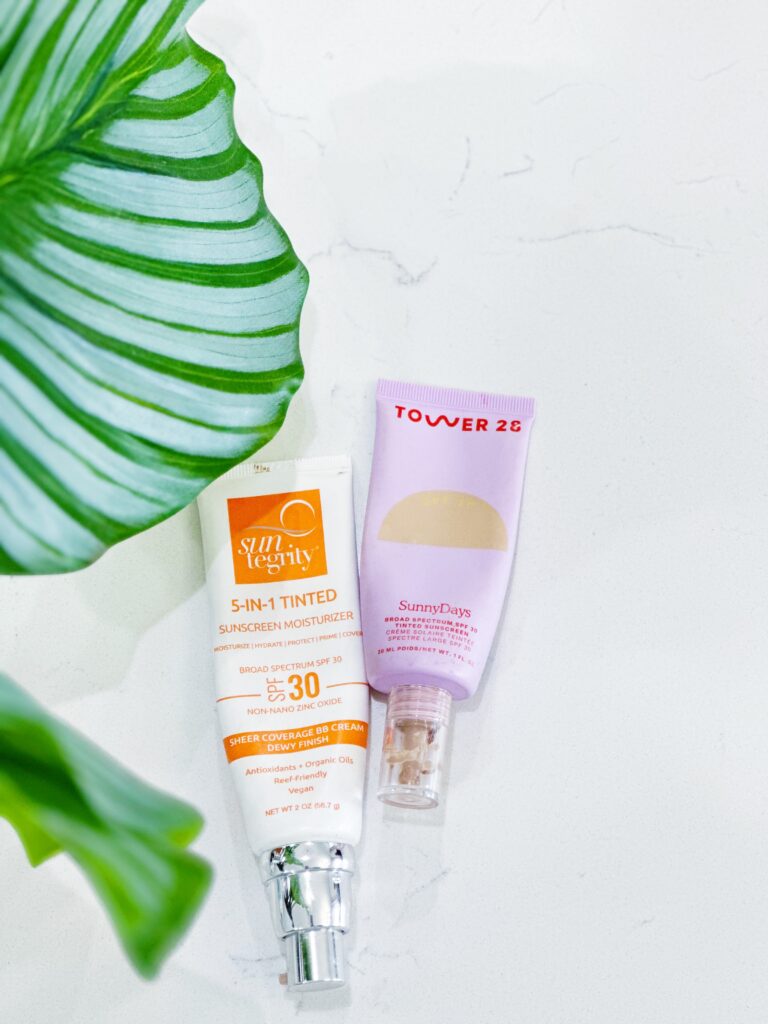
Suntegrity 5-in-1 Tinted Sunscreen Moisturizer SPF 30
**This will provide more of a foundation-like coverage**
Formula: A lotion that is weightless and provides a dewy finish. Available in 4 shades.
SPF: 30
Active Ingredient(s): 20% non-nano zinc oxide
White Cast: None
Water Resistant: No
EWG Score: 2 – check it out here!
Price: $45
Review
I love this tinted sunscreen! This has been another product that I’ve used for years. It offers light to medium coverage. It has more of a cream texture, versus a liquid texture. It really gives my skin a glow and hydrates well. It doesn’t feel heavy on the skin. Especially great if you prefer a little more coverage than a typical tinted moisturizer.
Tower 28 Sunny Days Tinted SPF Foundation SPF 30
**This will provide more of a foundation-like coverage**
Formula: A buildable lotion that can provide light to medium coverage. Available in 14 shades.
SPF: 30
Active Ingredient(s): 12.6% non nano zinc oxide
White Cast: None
Water Resistant: No
EWG Score: No score available
Price: $30
Review
I am so impressed with this product! It is my new favorite tinted moisturizer. Not only does it cover redness and imperfections but it helps to give skin a glow. My skin didn’t feel like it had a mask on at all but just a natural glow! I’ve found with a lot of tinted moisturizers they don’t provide much coverage- not with this one. It really does such a great job of helping to even out redness.
Related Content: Tower 28 Beauty Review
Blissoma Photonic Light Shifting Solution SPF 25
***Also Best Natural Face Sunscreen***
**This will provide more of a tint and is lighter coverage than my other picks**
Review
This tinted face sunscreen was also one of my picks for Best Natural Face Sunscreen so you can check out all the details there. Because of its slight tint it blends in so well and is lightweight.
Related Content: Best Natural Tinted Moisturizers (With SPF)
Best Tinted Body Sunscreen
Suntegrity Sport Mineral Tinted Body SPF 30
Formula: A moisturizing, unscented tinted body lotion available in a tube.
SPF: 30
Active Ingredient(s): 20% non-nano, uncoated zinc-oxide
White Cast: None
Water Resistant: Up to 80 minutes
EWG Score: 2 – check it out here!
Price: $24
Review
This is another sunscreen that I was very impressed with after using. It blended in so well and didn’t feel heavy. It blends in so nicely and doesn’t feel greasy. I even used this on my face and it wasn’t too heavy.
Best Sunscreen For Sensitive Skin

Unscented Suntegrity SPF 30 Mineral Body Sunscreen
Formula: Hydrating, yet not greasy. It absorbs so well.
SPF: 30
Active Ingredient(s): 20% non-nano zinc-oxide
White Cast: No white cast and rubs in well.
Water Resistant: No
EWG Score: 2 – check it out here!
Price: $24
Review
I love this formula. It really doesn’t feel like you’re wearing a heavy sunscreen like a lot of formulas which I love. It’s also nice that it works for babies and kids too. The unscented formula works well for sensitive skin types too. I think this is a great everyday sunscreen option but maybe not the one I grab when I’m going to be in heavy water all day.
Pipette SPF 50 Mineral Sunscreen
***Also Best Natural Sunscreen For Babies and Kids***
Review
This sunscreen was also one of my picks for Best Natural Sunscreen For Babies and Kids so you can check out all the details there. This sunscreen will work for the whole family, even the littles with the most sensitive of skin!
Le Prunier Plumscreen
***Also Best Natural Face Sunscreen***
Review
This sunscreen was also one of my picks for Best Natural Face Sunscreen so you can check out all the details there. This sunscreen is unlike any other sunscreen out there! Those with sensitive skin will definitely want to check it out.
Best Natural Stick Sunscreen
Suntegrity Mineral Sport Sun Stick SPF 30
Formula: A solid stick formulation that will glide on smoothly – no greasy feeling!
SPF: 30
Active Ingredient(s): 20 % non-nano zinc oxide
White Cast: There is a white hue initially but it can be rubbed in.
Water Resistant: Up to 80 minutes
EWG Score: 2 – check it out here!
Price: $26
Review
I LOVE this stick. Sometimes you just don’t want something that is a liquid. This is especially great for travel. It is easy to apply quickly to kids too. I liked it for its easier application. I would often leave it on my kid’s face white. It made me aware of where I put sunscreen or if I felt they needed extra protection.
I hoped this helps you when choosing a natural mineral sunscreen! What’s your favorite clean beauty sunscreen?
If you liked this post on the best natural mineral sunscreens, check out past posts below:
- 16 Pregnancy Safe Sunscreens
- Ilia Skin Tint (SPF 40) Review
- Native Sunscreen Review
- Cocokind Sunscreen Review
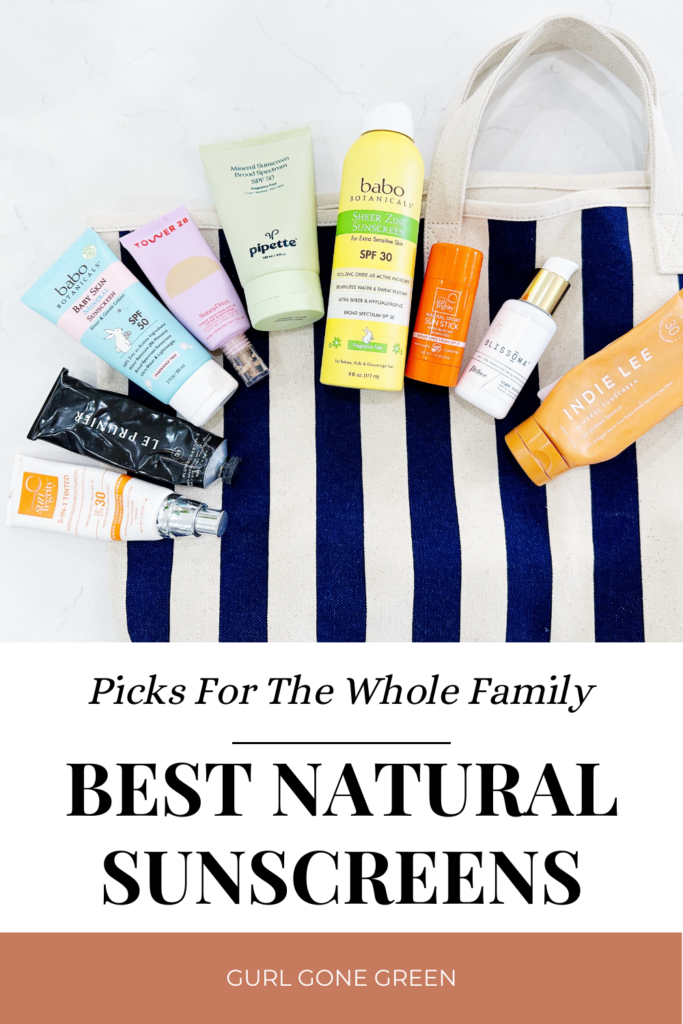
Sources:
- 2018, Grand View Research. U.S. Sun Care Market Size, Share & Trends Analysis Report. 1. https://www.grandviewresearch.com/industry-analysis/us-sun-care-market
- 2020, EWG. Sunscreen: How it works and what it means. 1. https://www.ewg.org/sunscreen/faqs-your-sunscreen-questions-our-answers/
- American Academy Of Dermatology Association. Sunscreen FAQs. 1. https://www.aad.org/public/everyday-care/sun-protection/sunscreen-patients/sunscreenfaqs#:~:text=Apply%20enough%20sunscreen%20to%20cover%20all%20skin%20that,your%20ears%20and%20the%20top%20of%20your%20head.
- 2018 Feb 17, J Cosmet Dermatol. Pubmed.gov. Dermatological and environmental toxicological impact of the sunscreen ingredient oxybenzone/benzophenone-3. https://pubmed.ncbi.nlm.nih.gov/29086472/
- 2020, Jan 21, Murali K. Matta, PhD, JAMA. Effect of Sunscreen Application on Plasma Concentration of Sunscreen Active IngredientsA Randomized Clinical Trial. https://jamanetwork.com/journals/jama/fullarticle/2759002?guestAccessKey=81a4a1e1-66d2-4f85-8d80-8d4d1aa1c56e&utm_source=For_The_Media&utm_medium=referral&utm_campaign=ftm_links&utm_content=tfl&utm_term=012120
- 2020 June 11, Capritto Amanda. CNet.com. Mineral Sunscreen vs. Chemical Sunscreen: Which is safer? https://www.cnet.com/health/mineral-vs-chemical-sunscreens-safety/
- 2008 Jan 3, R. Danovaro, Department of Marine Sciences, Faculty of Science, Polytechnic University of the Marche. Environmental Health Perspectives. https://www.ncbi.nlm.nih.gov/pmc/articles/PMC2291018/
- 2008 Jan 3, Department of Marine Sciences 2 Institute of Biochemistry and 3 Department of Chemical Sciences and Technologies, Faculty of Science, Polytechnic University of the Marche, Ancona, Italy. Sunscreens Cause Coral Bleaching by Promoting Viral Infections. https://www.ncbi.nlm.nih.gov/pmc/articles/PMC2291018
- 2011, June 9, Mayo Clinic Staff. Mayo Clinic. Best sunscreen: Understand sunscreen options. https://www.mayoclinic.org/healthy-lifestyle/adult-health/in-depth/best-sunscreen/art-20045110
- 2019, Nov, Khan Ibrahim, Science Direct. Nanoparticles: Properties, applications, and toxicities https://www.sciencedirect.com/science/article/pii/S1878535217300990

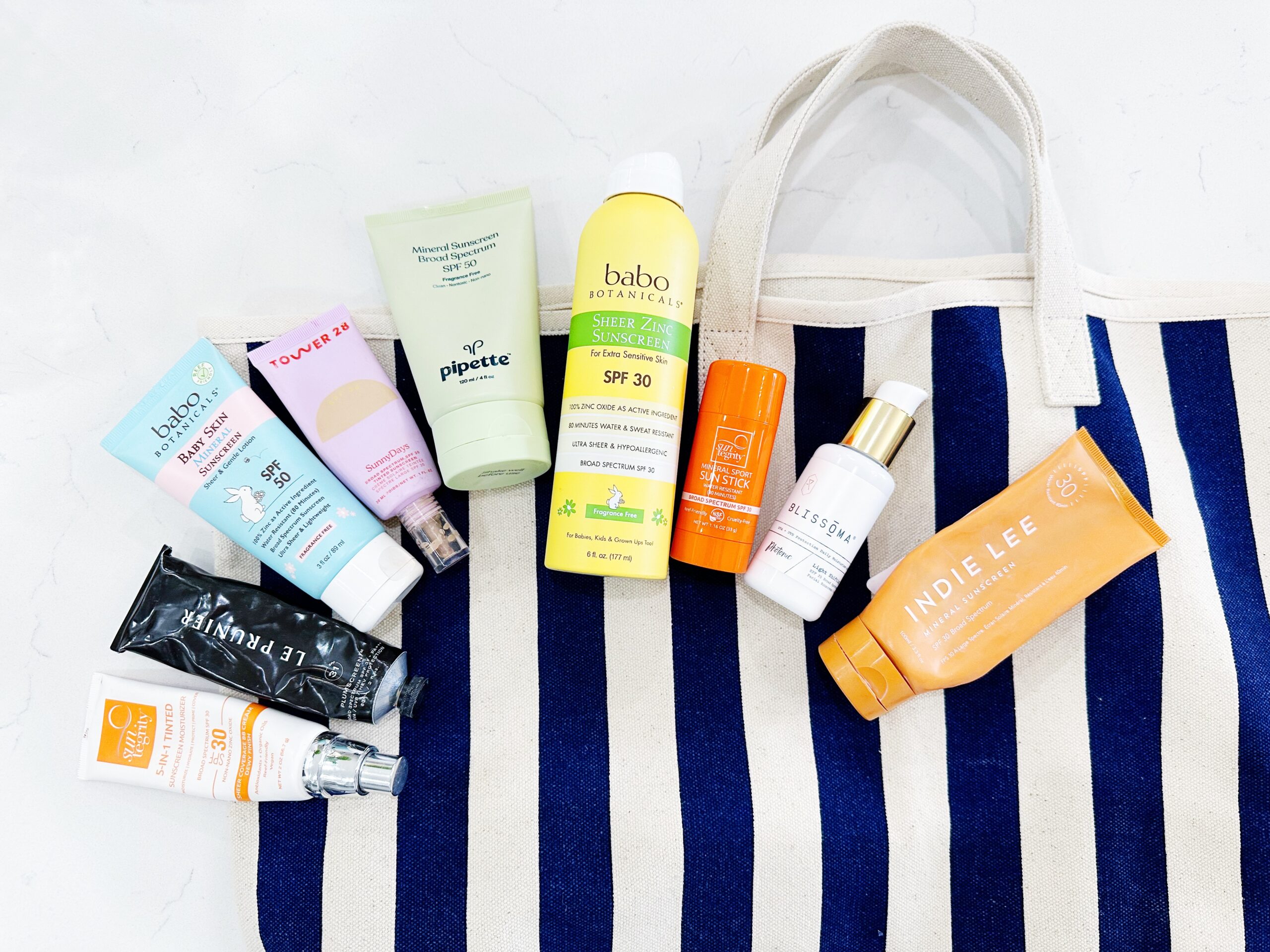


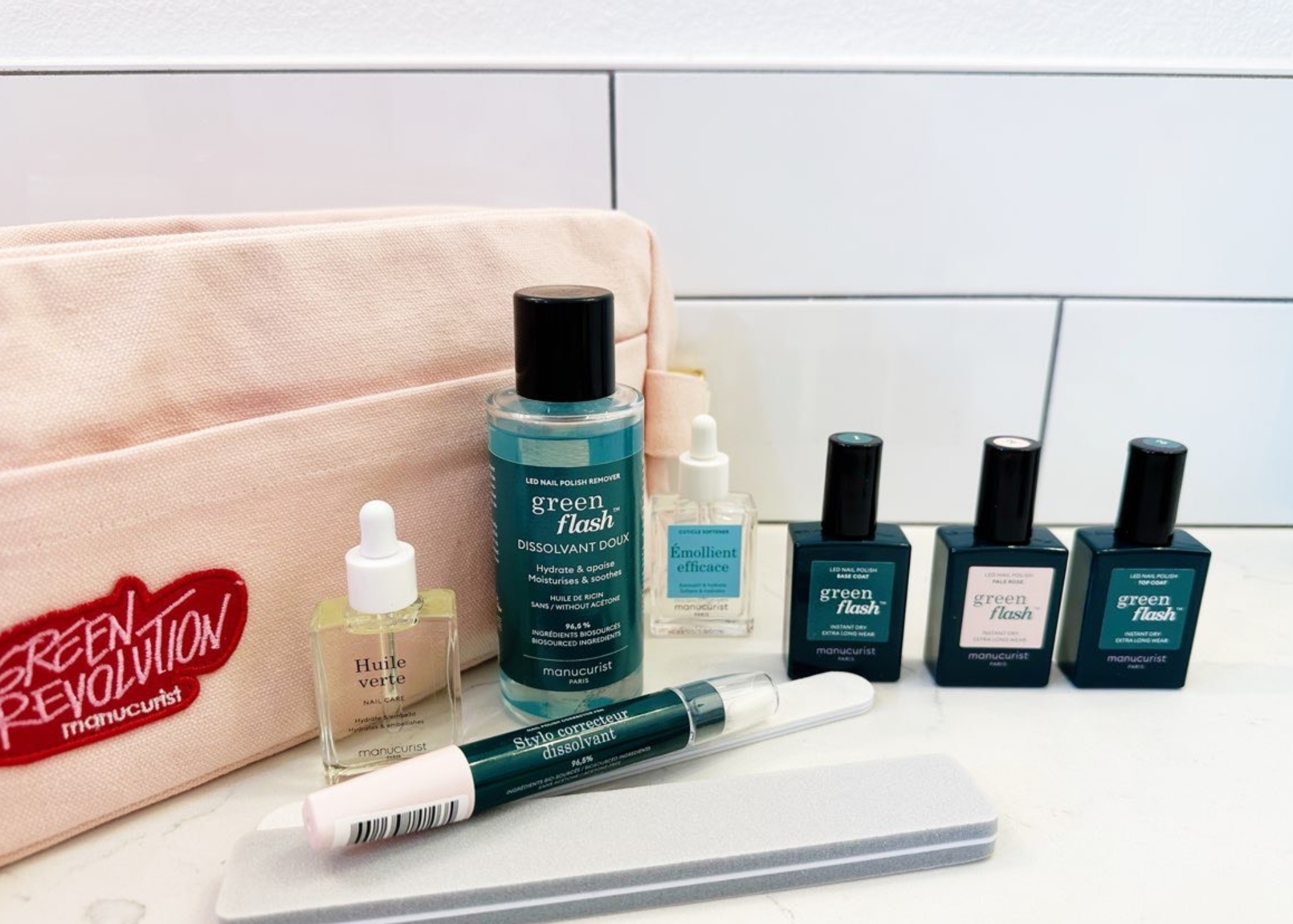
Which sunscreen is best for the face for daily use? I have sensitive skin too.
I love Beautycounter’s Sheer defense Daily Sunscreen! Really lightweight and not greasy.